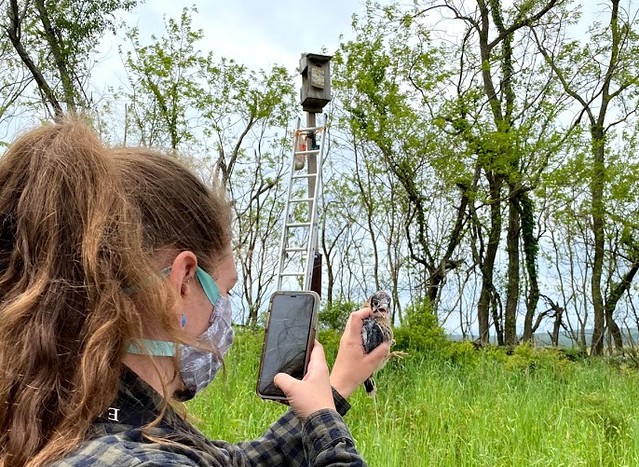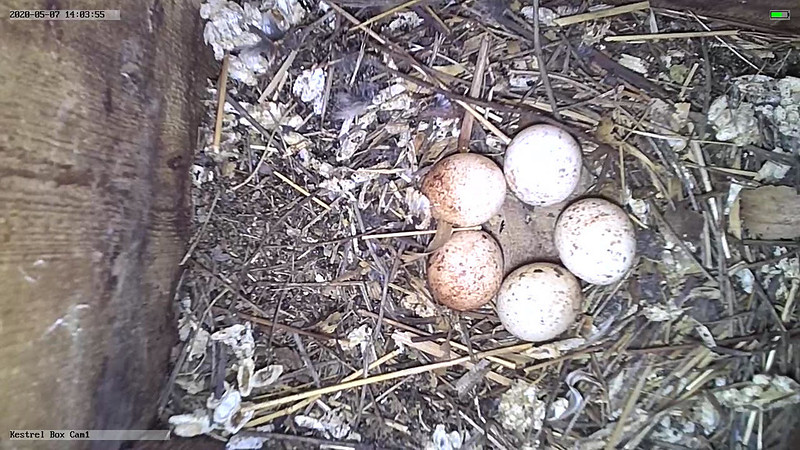Read Our Blogs
Birds of Prey at Sky Meadows State Park
Sky Meadows State Park is known for its vast variety of birds and wildlife, including beautiful birds of prey known as raptors.
Catching a glimpse of these majestic creatures perched on a pasture fence post or soaring on a thermal is a delight that may treat our visitors as they survey the pastoral landscape. Look for them taking advantage of the updraft caused by rising of warm air (thermal soaring) to fly at great heights without flapping their wings.
The park provides habitat to many native species of raptors, but the thriving population of some of these birds at Sky Meadows is no accident. There is a concerted conservation effort, involving many concerned individuals and organizations, to support the habitats and breeding of these treasured birds of prey.
Kestrel box monitoring at Sky Meadows State Park
Not unlike the ubiquitous bluebird boxes that dot the rolling pastoral landscape, another nesting box project in the park provides habitat for the American Kestrel (Falco sparverius). In partnership with the Virginia Society of Ornithology (VSO), Sky Meadows has seven Kestrel boxes, included in the VSO’s American Kestrel Nest Box Project.
Over the years, this project has provided over 450 boxes in 44 Virginia counties, including in 15 Virginia State Parks. The VSO is part of an intricate collaboration of conservationists, donors, volunteers and park staff working to understand and address the decline in the Kestrel population that has occurred since the 1960s.
By building, maintaining and monitoring the Kestrel boxes, scientists and citizen scientists are learning more about the factors causing the decline in population, as well as improving the Kestrels’ chances of survival and breeding for future generations.
Kestrel Box 6 containing 5 Kestrel Eggs
The nesting boxes at Sky Meadows are strategically placed along trails and meadows and built to attract these cavity nesters who; otherwise, do not build their own nests. The American Kestrel Partnership, whose mission promotes increased awareness, understanding and conservation of the American Kestrel, provides important guidance for box construction, placement and data collection. Keep an eye out for these tall boxes on your next hike.
Kestrel Box 4 containing young Kestrels
Sky Meadows also provides man-made habitats for the nocturnal Barn Owl (Tyto alba). Like the Kestrels and other raptors, owl populations have declined in some areas due to habitat loss and other factors.
There are currently two Barn Owl nesting boxes at Sky Meadows that are carefully monitored and maintained by professional and volunteer citizen scientists, in much the same way as the bluebird and Kestrel boxes.
Barn Owl nesting boxes are also maintained and monitored at the park
The birds at the park have benefited especially from the passion of one committed volunteer, Alan Williams, who has contributed greatly to the field of knowledge on raptors. He has been involved in Kestrel box monitoring in Virginia for several years, and began work with boxes in Virginia State Parks in 2019.
In Mr. Williams’ words: “This year I have worked to monitor and maintain 200 plus boxes for kestrels and owls with a small handful of helpers. We record our observations and submit them to American Kestrel Partnership and to NestWatch both of which use this sort of data collected by volunteers around the country to help address scientific and management questions.”
Mr. Williams is also involved in bird banding, as another way of collecting data on owls and kestrels at Sky Meadows and elsewhere in the Commonwealth. He and other concerned scientists use banding to track bird behavior, and submit findings to the U.S. Bird Banding Lab.
Perhaps you will be lucky enough to spot an American Kestrel while visiting
These are just a few examples of the many resources available to support our feathered fellows. There are many concerned individuals, across different non-profit organizations and government agencies, including many unaffiliated bird enthusiasts who just wish to take their bird-watching to the next level. Their collaboration makes them an extension of the very interwoven eco-system they are working to protect.
Humans throughout history have attached symbolic meaning, such as power, wisdom and individual freedom, to birds of prey. It is quite fitting that they represent these ideas to us, because human knowledge and advocacy will be needed to protect these birds for years to come.
If bird-watching is a passion of yours, consider turning your observations into action. You can start by appreciating the splendor of the raptors. Take a walk on Rolling Meadows Trail or South Ridge Trail at Sky Meadows to spot an American Kestrel or one of their boxes.
If you are inspired to join the ranks of citizen scientists collecting data on raptors, explore one of the resources mentioned above. If you want to get involved in nature conservation at Sky Meadows State Park, contact the park’s Volunteer Coordinator, at skvolunteer@dcr.virginia.gov.
If you have read the article and have a question, please email nancy.heltman@dcr.virginia.gov.



















